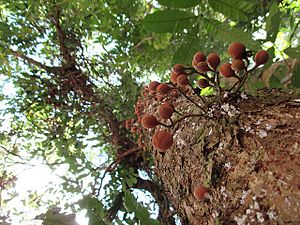Yellow mahogany facts for kids
Quick facts for kids Yellow mahogany |
|
|---|---|
 |
|
| Fruiting small tree, Mossman Gorge, Queensland, 26 Oct 2014 | |
 |
|
| Small tree close-up with cauline, developing fruit capsules, Mossman Gorge, Queensland, 26 Oct 2014 | |
| Scientific classification | |
| Genus: |
Dysoxylum
|
| Species: |
parasiticum
|
| Synonyms | |
|
List
Alliaria caulostachya Kuntze
Alliaria ramiflora Kuntze Alliaria speciosa Kuntze Azedarach ramiflorum Noronha Dysoxylum brachypodum Baker f. Dysoxylum callianthum Merr. & L.M.Perry Dysoxylum caulostachyum Miq. Dysoxylum densevestitum C.T.White Dysoxylum fissum C.T.White & W.D.Francis ex Lane-Poole Dysoxylum leytense Merr. Dysoxylum loheri Merr. Dysoxylum longicalicinum C.DC. Dysoxylum longiflorum Merr. Dysoxylum longipetalum C.DC. Dysoxylum megalanthum Hemsl. Dysoxylum novoguineeuse Warb. Dysoxylum ramiflorum Miq. Dysoxylum richardianum Merr. & L.M.Perry Dysoxylum robinsonii Merr. Dysoxylum roemeri C.DC. Dysoxylum rumphii Merr. Dysoxylum schiffner F.Muell. Dysoxylum sericeum (Blume) Adelb. Dysoxylum speciosum (A.Juss.) Miq. Epicharis brachypoda (Baker f.) Harms Epicharis calliantha (Merr. & L.M.Perry) Harms Epicharis cauliflora Blume Epicharis caulostachya (Miq.) Harms Epicharis densevestita (C.T.White) Harms Epicharis hyacinthodora Harms Epicharis leytensis (Merr.) Harms Epicharis loheri (Merr.) Harms Epicharis longicalycina (C.DC.) Harms Epicharis longiflora (Merr.) Harms Epicharis longipetala (C.DC.) Harms Epicharis megalantha (Hemsl.) Harms Epicharis ramiflora (Miq.) Pierre Epicharis robinsonii (Merr.) Harms Epicharis rumphii (Merr.) Harms Epicharis schiffneri (F.Muell.) Harms Epicharis sericea Blume Guarea cauliflora Reinw. ex Blume Guarea sericea Spreng. |
|
Dysoxylum parasiticum, also known as yellow mahogany, is a type of tree found in rainforests. It belongs to the Meliaceae plant family. The second part of its scientific name, parasiticum, comes from a Latin word meaning "parasitic." This name was given because people once thought its flowers grew on other trees like parasites, but we now know this isn't true.
Contents
What is Yellow Mahogany?
How Scientists Name Plants
In 1751, a Swedish scientist named Pehr Osbeck first described this tree. He called it Melia parasitica. Later, in 1966, an Indonesian botanist named André Joseph Guillaume Henri Kostermans moved it to a different group of trees, the Dysoxylum genus. This is how plants sometimes get new scientific names as scientists learn more about them.
Other Names for This Tree
People in different places have their own names for Dysoxylum parasiticum. For example, the Bajau people in Sabah, a state in Malaysia, call it jarum-jarum. In Queensland, Australia, it's commonly known as yellow mahogany.
What Does Yellow Mahogany Look Like?
Dysoxylum parasiticum trees can grow very tall, up to 36 meters (about 118 feet). Their trunks can be as wide as 60 centimeters (about 2 feet) across. The base of the trunk often has large, flat supports called buttresses, which can spread out up to 1.5 meters (about 5 feet).
Bark, Flowers, and Fruits
The bark of the tree is smooth and can be yellowish to grey-brown. The flowers are white or creamy and have a sweet smell. The fruits are round and reddish-brown, growing up to 4 centimeters (about 1.5 inches) wide.
What's special about this tree is how its flowers and fruits grow. They can grow directly from the main trunk of the tree, even near the ground. This is called cauliflory. They can also grow from the large branches, which is known as ramiflory.
Where Does Yellow Mahogany Grow?
Natural Habitat and Range
Dysoxylum parasiticum trees grow naturally in many parts of the world. You can find them in Taiwan, across a region called Malesia (which includes countries like Malaysia, Indonesia, and the Philippines), and all the way to New Guinea, the Solomon Islands, and Queensland, Australia.
Where They Thrive
These trees live in rainforests, from areas right by the sea up to mountains as high as 2,100 meters (about 6,900 feet). In Queensland, they are found from sea level up to 1,400 meters (about 4,600 feet) high, for example, in places like Mount Bellenden Ker.
How Can We Use Yellow Mahogany?
Growing This Tree
Dysoxylum parasiticum could be a great tree to plant in parks or large gardens, especially in places with warm, wet climates (subtropical or tropical). It grows best in soil that is a bit acidic, drains water well, and gets some sunlight but also some shade. You can grow new trees from fresh seeds.

